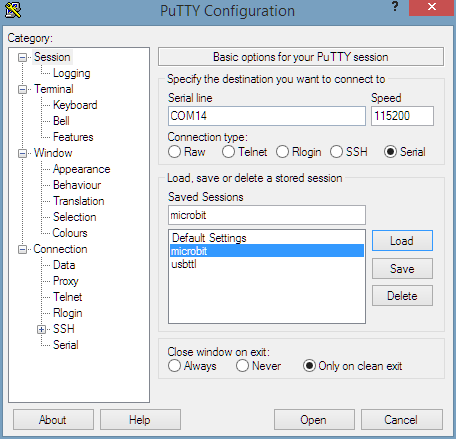

- #PUTTY FOR MAC FOR USB SERIAL HOW TO#
- #PUTTY FOR MAC FOR USB SERIAL INSTALL#
- #PUTTY FOR MAC FOR USB SERIAL SERIAL#
You can set up the virtual serial ports in two virtual machines to connect to each other. On your host computer, configure the application that communicates with the virtual machine to use the same Unix socket name.Click OK to save your configuration and close the virtual machine settings editor.In the Path field, enter /tmp/ or another Unix socket name of your choice.On your host computer, configure the application that communicates with the virtual machine to use the same pipe name.You may deselect this setting if you wish. By default, the device status setting is Connect at power on.Select The other end is an application.In general, select This end is the server if you plan to start this end of the connection first. Select This end is the server or This end is the client.The pipe name must follow the form \\.\pipe\ that is, it must begin with \\.\pipe\. Use the default pipe name, or enter another pipe name of your choice.Select Output to named pipe, then click Next.
#PUTTY FOR MAC FOR USB SERIAL INSTALL#
To install a direct serial connection between an application on the host and a virtual machine, take the following steps: This is useful, for example, if you want to use an application on the host to capture debugging information sent from the virtual machine's serial port. You can set up the virtual serial port in a virtual machine to connect to an application on the host computer.

You may deselect this setting if you wish.Ĭonnecting an Application on the Host to a Virtual Machine By default, the device status setting is Connect at power on. Browse to the file on the host computer that you want to use to store the output of the virtual serial port.Select Output to file, then click Next.To install a virtual serial port that connects to a file on the host computer, take the following steps: This is useful, for example, if you want to capture the data a program running in the virtual machine sends to the virtual serial port or if you need a quick way to transfer a file from the guest to the host. You can set up the virtual serial port in a virtual machine to send its output to a file on the host computer. Click Finish, then click OK to close the virtual machine settings editor.For more information, see Special Configuration Options for Advanced Users. This option is of interest primarily to developers who are using debugging tools that communicate over a serial connection. You may deselect this setting if you wish.Ĭlick Advanced if you want to configure this serial port to use polled mode. Choose the port on the host computer that you want to use for this serial connection.Select Use physical serial port on the host, then click Next.Click Add to start the Add Hardware Wizard.Open the virtual machine settings editor ( VM > Settings).To install a virtual serial port that connects to a physical serial port on the host computer, take the following steps: This is useful, for example, if you want to use an external modem or a hand-held device in your virtual machine. You can set up the virtual serial port in a virtual machine to use a physical serial port on the host computer. You can also select whether to connect the virtual serial port when you power on the virtual machine. You can make a direct connection between two virtual machines or between a virtual machine and an application running on the host computer.You can connect a virtual serial port to a file on the host computer.You can connect a virtual serial port to a physical serial port on the host computer.The virtual serial ports can be configured in several ways. Examples: Debugging over a Virtual Serial PortĪ VMware Workstation virtual machine can use up to four virtual serial ports.Special Configuration Options for Advanced Users.Connecting an Application on the Host to a Virtual Machine.Using a Serial Port on the Host Computer.
#PUTTY FOR MAC FOR USB SERIAL HOW TO#
The following sections describe how to use serial ports with VMware Workstation: Features | Documentation | Knowledge Base | Discussion Forums


 0 kommentar(er)
0 kommentar(er)
